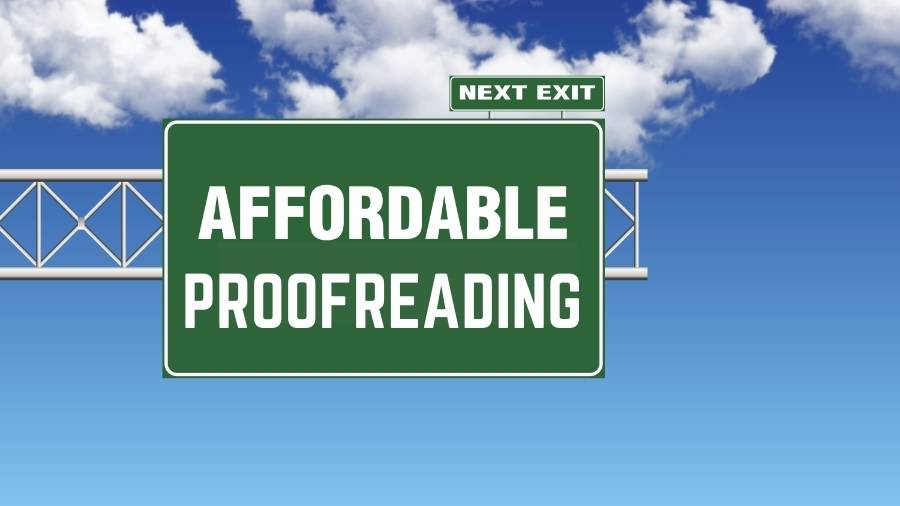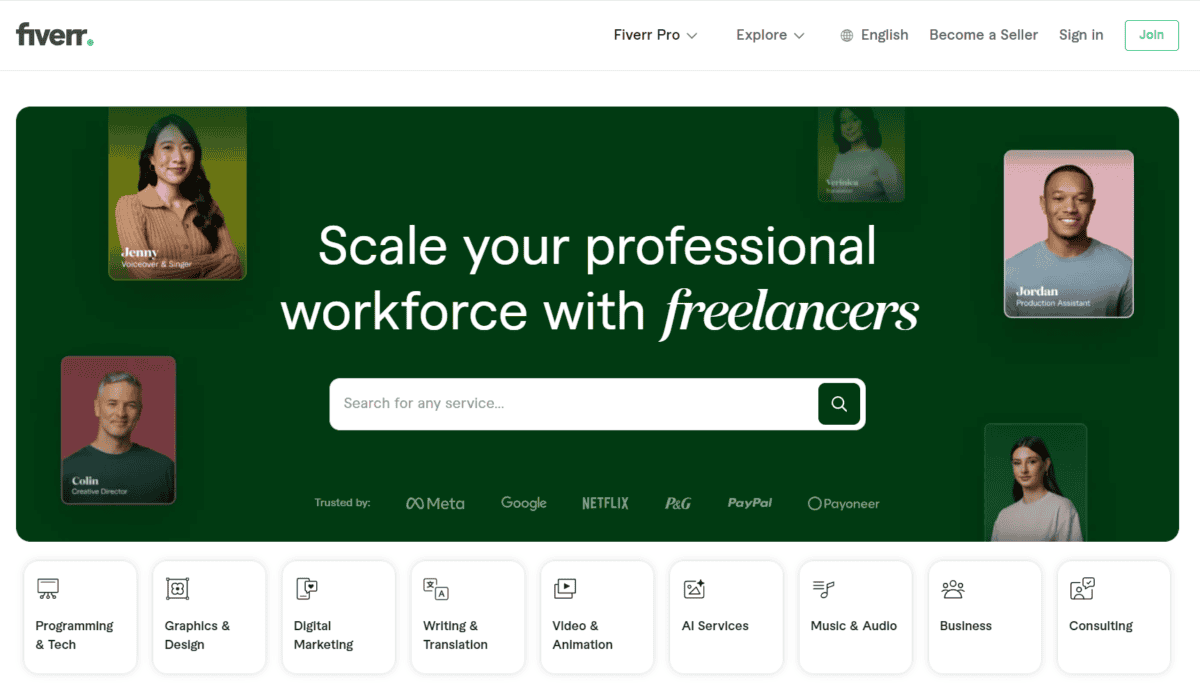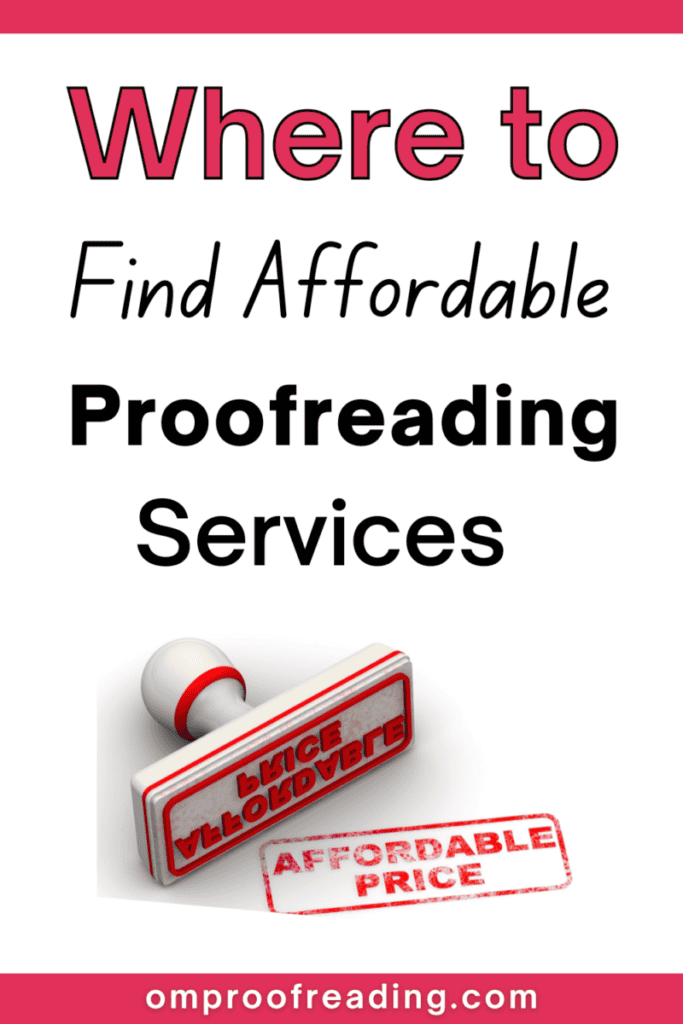This article may contain affiliate links. Please see our affiliate disclaimer in the footer menu for more information. Thank you for your support!

You know that hiring a proofreader is essential if you want your written communication to be clear, effective, and professional. However, finding pocketbook-friendly proofreading services can be challenging. As a proofreader who works in the field, I can help you find the lowest prices.
The best place to find affordable proofreading services is on freelance platforms. This is because, in general, you can find many beginner proofreaders who use these marketplaces to practice their skills and get valuable experience.
Let’s examine three popular platforms: Fiverr, Upwork, and Freelancer. We’ll discuss how to navigate them and how to determine whether a proofreader can provide high-quality work.
What Is Proofreading, and How Much Does It Cost?
Before searching for a proofreader, it’s essential to understand what they do to avoid misunderstandings.
What Proofreaders Do
Proofreaders correct punctuation, spelling, grammar, capitalization, and formatting errors.
They also check for omitted and repeated words and ensure that words are used correctly (e.g., imminent vs. eminent). They don’t fix problems with content or organization, nor do they do any rewriting.
Proofreading is typically done after a document has been copyedited.
How Much Proofreading Costs
Knowing how much proofreading typically costs is the only way to determine what constitutes an affordable price.
The Editorial Freelancers Association (EFA) in the US surveyed its members in 2023 to obtain data for their 2024 median rates chart.
EFA members who proofread nonfiction charge about $40–$50 per hour ($0.02–$0.03 per word) with a pace of 7–11 pages per hour.
The industry standard for a manuscript page is 250 words.
The UK’s Chartered Institute of Editing and Proofreading (CIEP) suggests a minimum hourly rate of £30.75.
However, the EFA and the CIEP acknowledge that proofreading rates vary widely depending on numerous factors, including turnaround time, the complexity of the document, and the quality of writing.
Proofreaders on freelance marketplaces typically charge lower rates than those suggested by editorial societies.
These proofreaders charge about $0.01–$0.02 per word, which is $2.50–$5.00 per page.
Although you’ll find inexpensive services on online marketplaces, you’ll need to register and pay a small service fee.
Here are the service fees for the three platforms we’ll discuss in this article.
Service Fees for Fiverr, Upwork, and Freelancer
| Platform | Fee (% of total payment) |
|---|---|
| Fiverr | 5.5% of purchase amount, $2.50 small order fee for purchases under $75 |
| Upwork | 5%, or 3% for eligible clients in the US who pay with a checking account |
| Freelancer | 3% for hourly projects; 3% or $3 (whichever is greater) for fixed-price projects |
Find Affordable Proofreading Services on Fiverr

If you’re after the lowest rates possible, Fiverr is your go-to platform.
It’s where I started my proofreading career.
I’ve chosen to discuss Fiverr separately from Freelancer and Upwork since it functions differently.
To locate proofreaders on Fiverr, you can type proofreading, book proofreader, proofreading and editing, or any other keyword into the search box.
Fiverr’s layout is visually appealing and easy to navigate.
What You See on Each Thumbnail
After you hit the search button, the thumbnails of numerous proofreaders will appear.
The proofreaders are called sellers; their services are known as gigs.
Many sellers offer more than one gig. Each thumbnail you see is a gig provided by a seller.
Each gig thumbnail includes the following:
- an image (usually a picture of the proofreader)
- a one-sentence description of their offer
- their overall rating out of five stars (for that gig, specifically)
- the total number of ratings received (for that gig)
- the starting price
- the seller’s level (level 1, level 2, or top-rated)
Note: New sellers will not yet have a level. Levels are determined by how many orders a seller has successfully completed. Successful completion of an order means that it was delivered on time and given at least a 4.8-star rating by the client.
The number of successfully completed orders required to achieve each level is as follows:

Level 1: 10
Level 2: 50
Top-Rated: unknown; these sellers are vetted by Fiverr
Delving a Bit Deeper
After the results appear, you can narrow them down by numerous categories, including budget and delivery time. When you’ve found a gig that meets your needs, click on it to learn more about the gig and the seller.
You’ll see the seller’s overall rating for all the gigs they offer. You’ll also learn where the seller is from and how long it usually takes them to respond to messages.
In general, sellers on Fiverr respond to messages quickly.
Some sellers have a portfolio where you can view a portion of their work on past projects.
Finally, you’ll see ratings and feedback from clients who purchased the specific gig you’re viewing.
Fiverr’s Unique Features
Each Fiverr seller has a helpful FAQ section.
You can also view a graph showing the total number of reviews a seller has received for each star rating (1–5).
For example, a seller might have 25 five-star ratings, 3 four-star ratings, 1 three-star rating, and no two- or one-star ratings.
Deciding If You’d Like to Purchase the Proofreader’s Gig

Most sellers offer a gig with three different packages, so you can select the one that best meets your needs. You’ll be able to compare the packages side by side while viewing the following information:
- the price
- what you’ll receive
- how many revisions are available to you (if any)
- the delivery time
- the number of words a gig covers
You then have the opportunity to place your order unless the seller wants you to contact them first.
You can communicate with Fiverr sellers via text message and video chat.
The hiring process is the main difference between Fiverr and the other two platforms we’ll discuss below.
On Fiverr, you typically don’t post a job for all the freelance proofreaders to see. Instead, you directly hire the proofreader who is best suited to your project.
However, you can post a job if you don’t have time to look for someone to hire.
If you take that route, look carefully at the profiles and reviews of the proofreaders applying to your job.
If you’d like to hire a proofreader on Fiverr, you can sign up here.
Inexpensive Proofreading on Upwork and Freelancer
Freelancer and Upwork allow you to contact a specific proofreader directly, but you have to start by posting a job (it’s free) on the platform.
The Hiring Process on Upwork and Freelancer
After registration, you’ll follow these steps:
1) Post a job.
You provide a few details about the proofreading job, which will be posted in front of freelancers with proofreading skills. (Upwork will give you a shortlist of candidates best suited to the assignment.)
You’ll receive proposals from freelancers interested in taking on your project.
2) Browse freelancers’ profiles.
After you’ve posted a job, you can peruse freelancers’ profiles to determine whether you want to contact anyone.
On Upwork, you can invite one or more proofreaders to submit a bid.
On Freelancer, you can make a direct offer to a proofreader after posting your job.
3) Compare the proposals and chat with freelancers.

You then review the proposals you’ve received and communicate with freelancers if you have any questions regarding their proposals.
You can communicate through text messages or video calls.
4) Select the best candidate for the job.
Finally, you hire the freelancer best suited to your project.
What You See on Each Freelancer’s Partial Profile
Like Fiverr, you can search for freelancers using keywords. A portion of each freelancer’s profile will be listed.
You’ll be able to view the following details for each person:
- their picture
- the type of work they do
- their overall rating (expressed as a job success percentage on Upwork)
- where they are from
- their hourly rate
Delving a Bit Deeper
You can use search filters (e.g., overall rating, hourly rate) to narrow down the pool of proofreaders.
Then you can select one to see their complete profile, where they discuss their qualifications, experience, and what they offer buyers.
Many freelancers also have a portfolio so you can view some of their past projects.
Finally, you can see the reviews (out of five stars) and comments left by clients for each job the freelancer has finished.
On Upwork, you can usually view a brief description of each freelancer’s completed jobs and current projects.
Upwork Has a Couple of Special Features
Upwork shows freelancers’ availability—more than 30 hours/week, less than 30 hours/week, or as needed.
It also notes whether a freelancer usually responds to invitations within 24 hours.
You can sign up here if you’d like to work with someone on Upwork.
Freelancer Has Unique Features Too
On each profile, you can see what time it is where the proofreader lives.
Also, all profiles show (as a percentage) the following details: jobs completed, jobs delivered on time, jobs delivered on budget, and repeat hire rate.
If you’d like to hire a proofreader on Freelancer, you can sign up here.
Top-Notch Tip: On all three platforms, you’ll notice a tiny green circle next to the seller’s name if they’re online. The seller is offline if the circle is gray (or nonexistent). On Upwork, if the circle is orange, they’re online but away.
How to Choose a Reliable Proofreader

What’s the point of hiring a proofreader if you can’t rely on them to do a decent job? Let’s see how to make sure you find someone who can do quality work.
Read the proofreader’s reviews.
Reviews are telling. If others have had a positive experience with a proofreader, you probably will too.
Be sure to look at their most recent reviews since those will be the most relevant.
Think about what you want most in a proofreader, then determine if the reviews match your needs.
Know the proofreader’s qualifications.
The proofreader’s profile will provide information about their education and job-specific training. Although having a college degree is a plus, it’s by no means an indication that someone is qualified to be a proofreader.
The most important factor is whether a proofreader has completed a reputable proofreading course.
It’s a positive sign if a proofreader has trained with any of the following organizations:
- Proofread Anywhere—based in the US
- Knowadays—based in the UK
- The Publishing Training Centre—based in the UK
- The Chartered Institute of Editing and Proofreading (CIEP)—based in the UK
Examine the proofreader’s experience.
If someone has worked as a proofreader at a company or has experience as a freelancer, you know they’ve had some time to hone their skills.

A proofreader’s portfolio can give you a general idea of how they work and what kinds of projects they’ve worked on in the past. Keep in mind that each project is different, and proofreaders sometimes follow specific guidelines or a style sheet provided by the client.
Witness the proofreader’s written communication.
Notice if the proofreader’s written communication is up to par.
If their profile is full of errors, you’ll want to look elsewhere.
Likewise, if you ask them questions and their responses contain several mistakes, it’s a red flag.
Inquire about the style guide they use.
A well-trained proofreader will be familiar with at least one commonly used style guide. It’s a good idea to ask them which one they usually use.
If they typically proofread US English, they’ll probably be familiar with The Chicago Manual of Style or The Associated Press Stylebook.
If they primarily proofread UK English, they’ll likely know about New Hart’s Rules: The Oxford Style Guide.
Top-Notch Tip: Start by giving the proofreader a small project.
For example, instead of handing over an entire manuscript, you could give the proofreader one chapter the first time you collaborate with them.
Then, you can hire them for more work if you’re happy with their performance.
Frequently Asked Questions
What is the average cost of proofreading?
On average, proofreading costs $0.01–$0.03 per word if you hire a freelancer and $0.03–$0.06 per word if you hire an online proofreading and editing company.
Let’s see how much it would cost to proofread 1,000 words (four pages) with this range of rates.
Cost to Proofread 1,000 Words at Various Per Word Rates
| Rate | Cost |
| $0.01 | $10.00 |
| $0.02 | $20.00 |
| $0.03 | $30.00 |
| $0.04 | $40.00 |
| $0.05 | $50.00 |
| $0.06 | $60.00 |
How long does it take to proofread 1,000 words?
It takes roughly 25 minutes to proofread 1,000 words. However, it can take anywhere from 15 to 40 minutes due to several variables (source). These variables include the genre and quality of writing, the technicality of the document, and the proofreader’s level of experience.
Om Proofreading discusses how long proofreading takes if you’d like to know more.
What is the difference between copyediting and proofreading?
Proofreading involves finding and correcting grammar, capitalization, spelling, punctuation, and formatting errors. Proofreaders also detect repeated or omitted words and problems with word choice (e.g., discreet vs. discrete). They ensure that the writing adheres to the relevant style guide.
Copyediting involves everything mentioned above; however, it has a different focus. Copy editors make writing clear, concise, and consistent. They improve sentence structure and eliminate wordiness. Some copy editors may alert the author to legal issues like libel and plagiarism.
I penned a post that explains the differences between copyediting and proofreading in more depth if you’re interested.
I hope this article has helped you with finding affordable proofreading services.
Good luck finding a proofreader who fits the bill! 😊
Best wishes to you!
“Everyone shines, given the right lighting.”
– Susan Cain

Recent Posts
Punctuation is important because it enables us to communicate our message clearly and effectively. Without punctuation, we wouldn’t understand how units of a sentence relate to one another or how...
Although you're probably somewhat familiar with adverbs, you may be unaware of sentence adverbs. As a trained proofreader who has studied the parts of speech, I can help you understand this unique...
